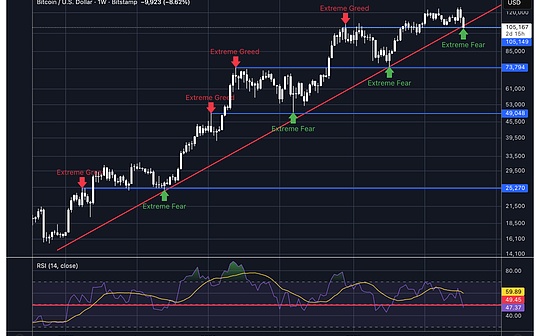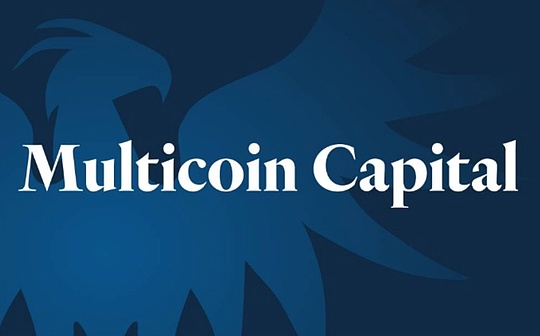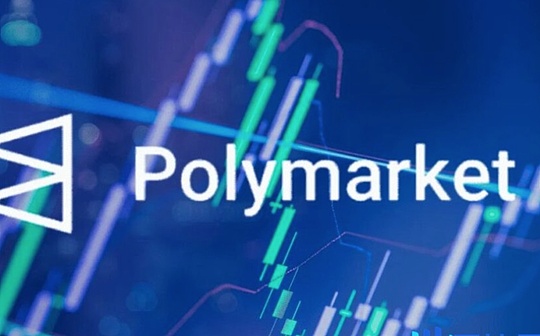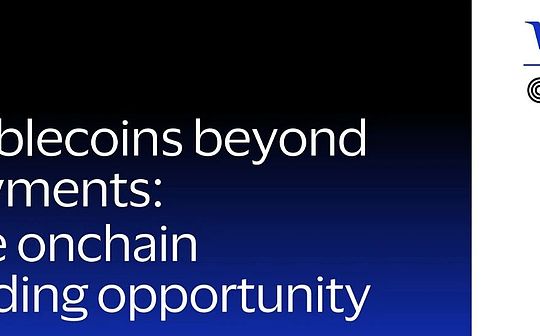
Stablecoins have evolved from crypto trading tools to infrastructure, and the core questions we are asked every day include: What specific use cases are there for stablecoins?What capabilities does it offer that traditional fiat currencies cannot?The most natural starting point is to view stablecoins as a new payment infrastructure and evaluate their potential benefits—such as instant, 24×7 settlement—especially in cross-border payment and remittance scenarios.
Although there are clear opportunities within the existing payment ecosystem, stablecoins are also givenThe transformative mission of promoting the modernization and automation of global lending and capital markets.
Stablecoins are unique in that they sit at the intersection of three massive markets: payments, lending and capital markets.
As stablecoins improve the efficiency of cross-border payments, they may become the cornerstone of emerging cross-border lending and global credit systems: using smart contracts to connect global capital and demand parties and automate the entire life cycle of loan agreements.
Although the integration of stablecoins as “programmable currencies” into mainstream finance is still in its early stages, the underlying smart contract infrastructure has been publicly deployed, tested in practice, and continues to expand in the decentralized finance (DeFi) ecosystem.Leveraging the publicly verifiable nature of blockchain, we are able to observe and track the size and performance of stablecoin-denominated loans issued through smart contracts.For example,In the past five years, stablecoin-denominated loans have accumulated more than 670 billion U.S. dollars, and have grown significantly year by year..
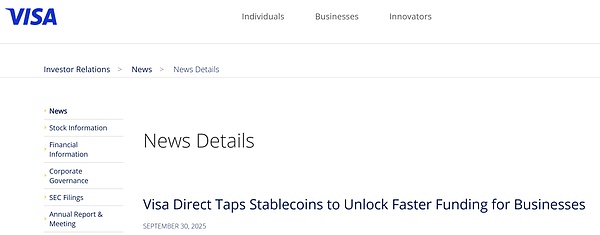
It is said that the end of payment is borrowing, so the potential of programmable currency of stablecoins based on blockchain & smart contracts is of great significance toInnovation in lending models and increased access to global creditVery attractive.
If previous on-chain lending was more suitable for cryptocurrency transaction scenarios, then with the passage of stablecoin legislation, subsequent on-chain lending will gradually be deeply embedded in real-life financial payment scenarios. Visa recently officially announced that its Visa Direct has launched a prefunding business using stablecoins, which is the best evidence.Visa also released a research report to explore how programmable currencies can reshape the global lending ecosystem after stablecoins are connected to smart contract-based lending protocols – making them more transparent, efficient and accessible.
This is also the direction we are actively exploring recently, whether it is the 2C global consumer finance scenario or the 2B cross-border supply chain finance scenario.In these explorations, we discovered that in markets across the Global South, these lending needs are far from being met!At the same time, the stablecoin payment channel can provide great convenience for these needs. Perhaps the integration of financial payments and an on-chain future of inclusive finance will be before our eyes.
“The real revolution lies not in electronic money, but in electronic trust.”——Dee Hock, founder of Visa
1. What is On-Chain Lending?
On-chain lending is an important application scenario in the crypto ecosystem. Whether on-chain or off-chain, it has successfully found a strong product-market fit.On-chain lending is an important part of building a digital asset financial ecosystem and is a subset of on-chain finance: a global credit market that is driven by stablecoins, operates automatically 24/7 and is always open.
On-chain lending completely reconstructs financial services by using smart contracts to replace traditional financial institutions and automatically complete financial intermediaries.Allows users to gain liquidity by staking their assets for deployment in the decentralized finance (DeFi) space, as well as transactions in on-chain and off-chain venues.
When combined with stablecoins, these protocols enable new lending models with automated execution, near-instant settlement, and borderless financial flows—essentially creating a global credit market that never closes.
On-chain stablecoin lending works as follows:
-
Lenders deposit stablecoins (such as USDC, USDT) into lending pools managed by smart contracts and earn deposit interest accordingly.
-
Smart contracts automatically complete the entire process of traditional loan services: calculating interest rates, monitoring the value of collateral in real time, performing liquidation when the mortgage rate falls below the required threshold, and distributing income to the lender.
-
To access funds, borrowers provide collateral (usually cryptoassets or tokenized real-world assets), which is locked in a smart contract.
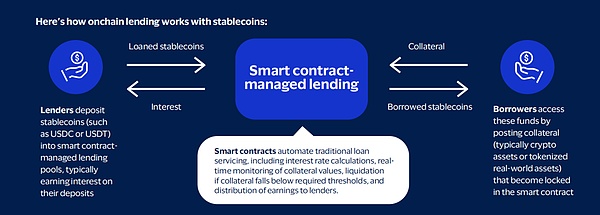
1.1 The role of stablecoins & new risk models
-
Improve capital market efficiency
-
Smart contracts continuously monitor the value of collateral and automatically adjust interest rates based on supply and demand algorithms—interest rates fall when capital utilization is low and rise when liquidity is tight.
-
Create an accessible 24×7 credit market
-
These global markets never close, operate automatically, and transparent pricing is visible to all participants.Anyone with internet access can lend and borrow money without permission from a central authority.
-
Provide a reliable value anchor
-
Stablecoins are denominated in legal currency to maintain stability, while having the flexibility and efficiency of programmable currencies, providing a credible pricing and settlement unit for both borrowers and lenders.
On-chain lending fundamentally changes the way risk is managed.Traditional lending typically assesses counterparty risk through credit checks and contract terms; on-chain lending reduces these specific risks through automatic liquidation – the protocol does not need to trust the borrower’s willingness to repay, but rather trusts the smart contract code to enforce the loan terms.
This does not eliminate risk, but transforms it into:
-
Counterparty risk can be managed with the help of smart contracts;
-
Technical risks have become a focus.Instead of analyzing balance sheets, liquidity providers must evaluate the protocol’s security audits, governance structure, and data source reliability.
1.2 Business model of on-chain lending
On-chain lending services are mainly provided through two channels: decentralized finance (DeFi) and centralized finance (CeFi), each with its own unique features and products.
Here is a brief overview of CeFi and DeFi lending:
A. Centralized Finance (CeFi)
CeFi refers to off-chain centralized financial institutions that provide cryptocurrency and related asset lending services, some of which use on-chain infrastructure or build their entire business on the chain.There are three main types of CeFi lending:
-
Over-the-counter (OTC): Over-the-counter trading services provided by centralized institutions, providing a range of tailored lending solutions and products.OTC transactions are conducted on a bilateral basis, allowing borrowers and lenders to enter into customized arrangements.Transaction terms, including interest rate, maturity date and loan-to-value (LTV), can be adjusted based on the specific needs of both parties.These services are generally only available to accredited investors and institutions.
-
Prime Brokerage: A comprehensive trading platform that provides margin financing, trade execution and custody services.Users can withdraw margin financing from the broker for other purposes, or leave it on the platform for trading activities.Brokers typically offer financing only on a limited set of crypto assets and crypto ETFs.
-
Onchain Private Credit: Allows users to pool funds on the chain and deploy them through off-chain protocols and accounts.In this case, the underlying blockchain actually becomes a platform for crowdfunding and accounting for off-chain credit needs.Debt is often tokenized, either as collateral assets or directly through tokens representing shares of the debt pool.The scope of use of funds is usually narrow.
B. Decentralized Finance (DeFi)
DeFi refers to applications driven by smart contracts that run on the blockchain, allowing users to borrow and lend using crypto assets as collateral, or to earn income through lending, or even obtain leverage in transactions.DeFi lending operates 24/7, offers a wide selection of loanable assets and collateral, and is completely transparent and auditable by anyone.
-
Lending Applications: On-chain applications allow users to deposit collateral assets (such as BTC and ETH) and use them as collateral to borrow other cryptocurrencies.Loan terms are based on the collateral assets and borrowed assets provided and are predetermined through the applied risk assessment.Lending through these applications is similar to overcollateralized lending in the traditional sense.
-
Collateral Debt Position Stablecoins: USD stablecoins that are over-collateralized by a single cryptocurrency or a group of cryptocurrencies.The principle is similar to over-collateralized lending, but a synthetic asset is generated when users deposit collateral.
-
Decentralized exchanges: Some decentralized exchanges allow users to obtain leverage to amplify trading positions.Although the functions of decentralized exchanges vary, the role of margin providers is similar to that of CeFi brokers.However, it is generally not possible to move funds out of decentralized exchanges.
2. Key data and insights
The global on-chain lending market is expanding rapidly, reaching a monthly scale of US$51.7 billion in August 2025, with more than 81,000 active borrowers, showing the size and growth rate of the stablecoin-driven credit market.
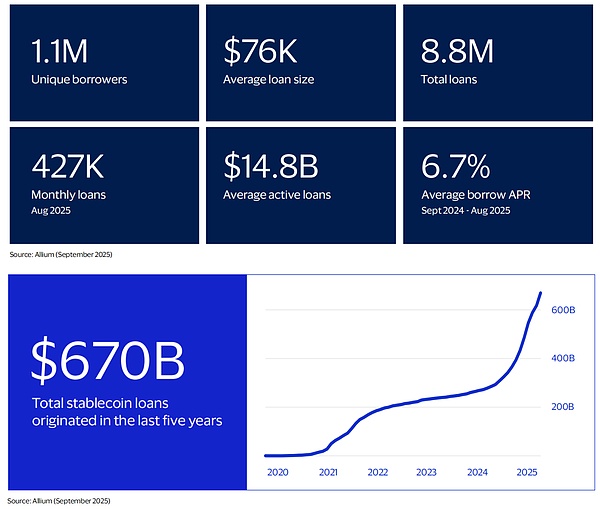
2.1 Transaction volume and borrowers
In August 2025, a total of $51.7 billion in stablecoins were lent, bringing the cumulative total of stablecoin lending since January 2020More than $670 billion.
From 2022 to early 2024, affected by the collapse of Terra Luna, FTX and multiple centralized crypto lending institutions, on-chain stablecoin lending activity fell sharply; however, it began to recover at the end of 2024 and hit new highs in recent months.
This recovery is also reflected in the number of loans and the number of unique borrower addresses: in August 2025, the number of loans reached 427,000 and the number of borrowing addresses reached 81,000.
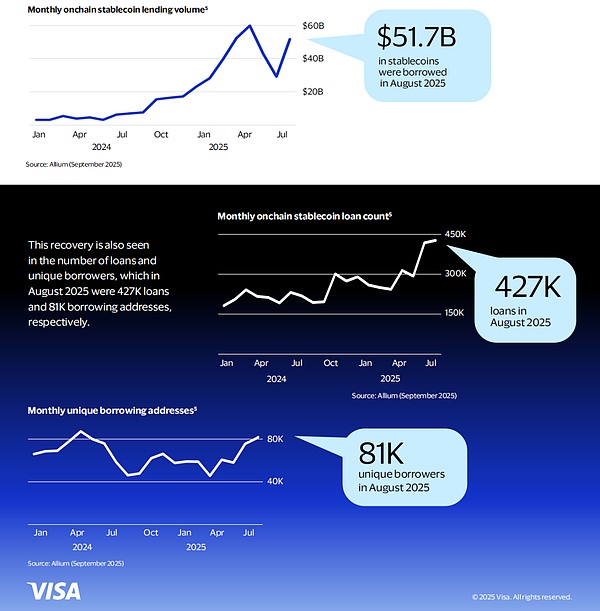
2.2 Trading volume by sector
Broken down, USDC and USDT occupy an absolutely dominant position, accounting for more than 99% of the historical cumulative lending volume, which is consistent with the two accounting for more than 98% of the total stablecoin supply under investigation.
In the previous cycle, lending mainly occurred in Ethereum, Avalanche, BSC, and Polygon.So far this round, Ethereum and Polygon still maintain the lead, accounting for 85% in August 2025; Base, Arbitrum and Solana’s shares have increased, accounting for 11% in the same period.
At the protocol level, Aave and Compound accounted for 89% of the monthly transaction volume in August 2025, ranking first in history; after Morpho launched V1 in early 2024 and V2 in June 2025, its share increased to 4%.

2.3 Single loan size
During the last round of trough, the average loan amount fell simultaneously, but has rebounded to the level of August 2025 as the market recovers.$121,000, reflecting a possible increase in institutional lending demand.
2.4 Outstanding loans and deposits
Active loan balances and the supply of stablecoins deposited into lending protocols also rebounded and exceeded the previous peak.In August 2025, average retention within the agreement$17.5 billionStablecoins, among which$14.8 billion (84%)is being lent in the form of a loan.

2.5 Interest rate level
Affected by price fluctuations of non-stable currency collateral such as ETH and BTC, on-chain stablecoin lending rates fluctuate, with borrowers’ annualized interest rate (APR) ranging from less than 2% to more than 16%.
The average interest rates in August 2025 are: APR for borrowings 6.4%, APY for deposits 5.1%; close to historical averages – the average APR for borrowings and APY for deposits over the past 12 months is 6.7%, 5.0%,The overall historical average is 6.4% APR for borrowings and 4.8% for deposits..This shows that, when backed by high-quality collateral, on-chain interest rates can be just a few percentage points different from traditional market lending rates.
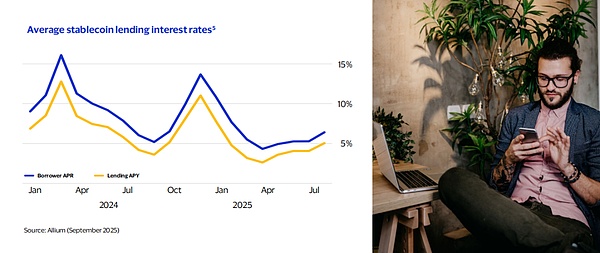
3. Major market participants
3.1 Key players in history
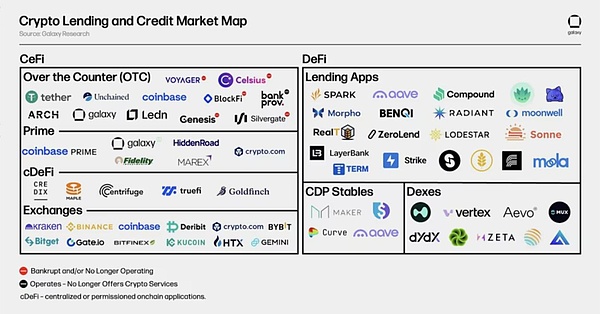
The chart above highlights some of the major past and present players in the CeFi and DeFi crypto lending markets.In 2022 and 2023, some of the largest CeFi lenders collapsed as crypto asset prices plummeted and market liquidity dried up.The most notable are Genesis, Celsius Network, BlockFi and Voyager, all four of which filed for bankruptcy within two years.This resulted in the total size of the CeFi and DeFi lending market shrinking by an estimated 78% from the peak in 2022 to the bear market trough, with CeFi lending experiencing an 82% decrease in outstanding borrowings.
The chart below compares some of the largest CeFi crypto lenders in history.Some companies offer multiple services to investors, such as Coinbase, which is primarily an exchange but also provides credit services to investors through over-the-counter cryptocurrency lending and margin financing.
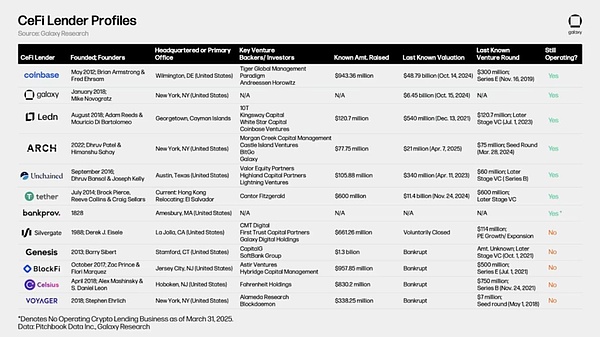
Although on- and off-chain crypto lending didn’t become widely used until late 2019/early 2020, some of the current and historically important players were founded as early as 2012.Genesis, which was founded in 2013 and has a loan portfolio of US$14.6 billion, is particularly noteworthy.On-chain lending giants like Aave, Sky (formerly MakerDAO), and Compound Finance launched on Ethereum in 2017-2018.The emergence of these on-chain lending/borrowing solutions is due to the birth of Ethereum and smart contracts, which were officially launched in July 2015.
The end of the 2020-2021 bull market marked the beginning of a tumultuous 18 months in the on-chain lending market, marked by a spate of bankruptcies.Significant events during this period included: Terra’s stablecoin UST depegged, eventually becoming worthless along with LUNA; stETH, the largest liquid collateralized token (LST) on Ethereum, depegged; and shares of the Grayscale Bitcoin Trust (GBTC) began trading at a discount to net asset value (NAV) after years of trading at a premium.
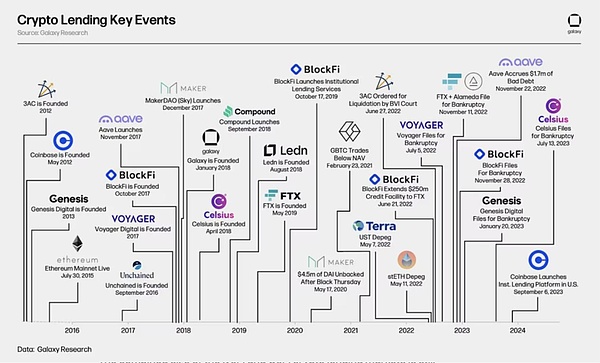
3.2 Innovative lending models under stable currency legislation
The recent surge in stablecoin lending highlights new use cases for stablecoins in on-chain finance.Protocols such as Morpho aggregate global liquidity through stablecoins and optimize the lending market; Rain, a card issuer linked to stablecoins, uses platforms such as Credit Coop and Huma Finance to fund its credit projects.In addition to card solutions, Credit Coop also conducts cash flow and income-based lending, while Huma leverages stablecoins to enable more efficient trade finance and faster cross-border payments.Leading lending protocols are using stablecoins to power card projects, cross-border payment financing, and aggregated lending markets, showing viable business applications beyond crypto capital markets use cases.
A. Morpho
Morpho is a lending protocol that aggregates demand and liquidity across platforms.As back-end lending infrastructure, Morpho integrates with third-party platforms and wallets such as Coinbase, BitPanda, Safe, Ledger, Trust Wallet, and banks such as Societe Generale.With Morpho’s “engine,” users of these platforms can share demand and liquidity from the same pool: USDC lent by one user on Coinbase, for example, might have originally been deposited by another Ledger wallet user.This model replaces traditional fragmented bilateral or tripartite lending relationships with a single multilateral lending market, thereby improving lending rates and capital efficiency.
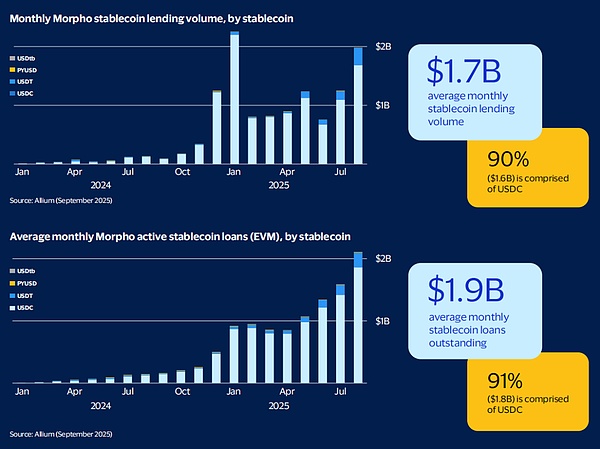
Currently, Morpho’s monthly stablecoin lending volume reaches $1.7 billion, and outstanding stablecoin loans are $1.9 billion; of which USDC accounts for $1.6 billion (90%) of lending volume and $1.8 billion (91%) of outstanding loans.The partnership with Coinbase is the biggest driver of this USDC activity: through Coinbase integration, Morpho has facilitated over $1 billion in USDC loan originations, with over $1.2 billion in cbBTC as collateral.
Morpho borrows USDC on Ethereum by aggregating USDC liquidity across platformsAnnualized returns can be as low as 4–5%, about half less than other crypto mortgage options.
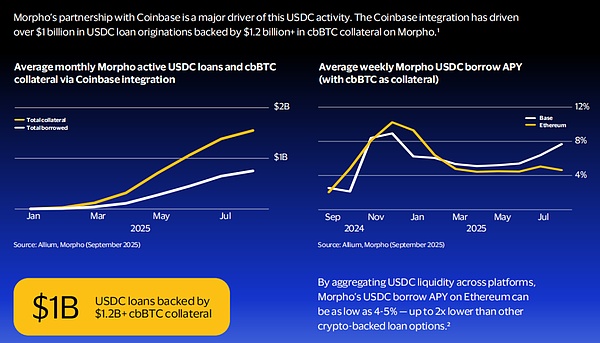
For exchanges, wallets and fintechs that work with Morpho, the protocol also improves user retention: in-app financial services allow users to borrow without moving assets, rather than selling them.Because Morpho’s market operates autonomously on the chain, with complete transparency of loan and collateral information, participants can obtain higher trust and more adequate information to manage market and counterparty risks.
B.Credit Coop
Credit Coop is a structured financial protocol that supports lending and borrowing against on-chain cash flow.Its smart contract allows lenders to automatically share profits from the borrower’s “income-generating contract”; once the borrower defaults, the contract will immediately transfer 100% of the income stream to the lender, achieving trustless recourse.
Rain, a stablecoin credit card issuer and Visa partner, obtains liquidity through Credit Coop: using the cardholder’s future repayment accounts receivable as collateral to borrow funds to meet daily operations.As a card issuer, Rain must settle cardholders’ consumption amounts with Visa on a daily basis, and users’ repayments are usually not withdrawn until the end of the month.Credit Coop’s “Spigot” technology places a programmable lockbox on these future repayment streams, allowing Rain to borrow funds in advance without additional collateral, solving the working capital timing mismatch problem.To date, Rain has borrowed or repaid more than 175 million USDC through Credit Coop, and this number is still accelerating as Rain’s user base expands.
On the acquirer’s side, crypto-native payment processor Coinflow also uses Credit Coop to provide merchants with instant advance services in USDC where “card payments have not yet been settled, but funds have been received in advance”.
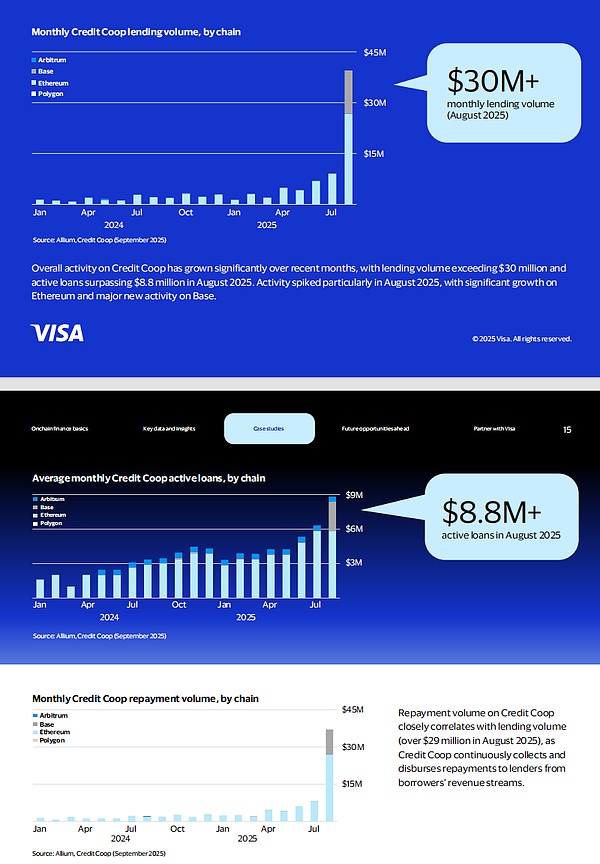
Overall, Credit Coop’s business volume has increased significantly in recent months: in August 2025, the loan amount exceeded US$30 million, and the outstanding loan balance exceeded US$8.8 million; there was a surge in August in particular, the scale on Ethereum expanded, and the Base chain also began to contribute major new increments.
Credit Coop’s repayment stream closely matches loan originations (over $29 million in repayments in August 2025), as the protocol continuously collects from borrowers’ income streams and distributes them to lenders on an instant basis.
For lenders, Credit Coop offers12–15% annualized return, and the chain is completely transparent, allowing real-time viewing of loan performance; at the same time, with programmed control of revenue-generating contracts, trustless recourse is achieved.The protocol also natively integrates deposit channels, so institutions can conveniently start lending and obtain on-chain income through bank wire transfer.
C.HumaFinance
Huma Finance is a “payment financing” platform that uses blockchain and stablecoins, specializing in compliant cross-border payment financing, stablecoin credit card financing, trade financing and other financing solutions.Its PayFi network provides businesses with three types of stablecoin lines of credit: revolving credit lines, accounts receivable collateralized lines of credit, and accounts receivable factoring lines.Currently, approved companies mainly use Huma to accelerate cross-border payments and supplier payments. Recipients can receive stablecoin funds immediately, thus eliminating the need for prepaid funds, capital lock-in, and related costs and delays.
Enterprises only need to pay on a daily basis during the duration of the loan balance (usually 6–10 basis points); because funds are withdrawn quickly (usually 1–5 days), the same capital can be reinvested frequently, so investors on Huma can obtain annualized returns of more than 10%.
Huma’s business will accelerate significantly from the second half of 2024.The current monthly transaction volume is about US$500 million, roughly half of which is lending and repayment; active liquidity has reached US$140 million, of which US$98 million of PayFi assets are in outstanding loan status, most of which are used in cross-border payment financing scenarios.
4. Outlook of future opportunities
The intersection of stablecoins and on-chain lending has given rise to three cutting-edge opportunities that we expect will reshape traditional finance over the next decade.
4.1 Tokenize assets to unlock collateral pools
The tokenization of real-world assets (RWA) is opening up a new blue ocean for on-chain lending collateral.The market has grown from $5 billion in December 2023 to $12.7 billion today; McKinsey predicts that total tokenized assets could reach $1–4 trillion by 2030.
BlackRock’s BUIDL fund is a model for institutional adoption, with its tokenized U.S. Treasury holdings hitting a record market capitalization of $2.9 billion in May 2025, and multiple on-chain lending protocols becoming its revenue distribution partners.Franklin Templeton’s OnChain U.S. Government Money Fund (BENJI) brought in an additional $800 million in tokenized bonds, while MakerDAO already has nearly 30% of its $6.6 billion balance sheet in real-world assets.
Traditional assets such as corporate bonds, private credit, and real estate will soon become collateral in the 7×24 global lending market.Connect the traditional credit market of more than 40 trillion US dollars with the efficiency and transparency of programmable currency to create a new source of liquidity for traditional assets.Large asset management companies are already piloting scalable solutions that are expected to tokenize tens of billions of addressable traditional assets one by one over the next decade.
4.2 Crypto-asset mortgage helps the next generation of credit plan
The credit card project is about to expand to a new model of “crypto-assets as collateral”, opening up incremental market space.First mover ether.fi is launching a non-custodial credit card that allows users to gain liquidity on their crypto holdings while retaining ownership of assets, avoiding capital gains taxes and continuing to enjoy upside exposure.Smart contracts monitor collateral in real time and can automatically trigger margin calls and risk disposal.Banks and private credit funds can serve as liquidity providers and export institutional funds to these plans through programmable lending protocols instead of traditional credit facilities, which not only creates new income opportunities for institutional investors, but also reduces counterparty risks through transparent and automated collateral management.
4.3 On-chain identity facilitates large-scale unsecured lending
One of the most transformative opportunities is unsecured lending based on on-chain behavior and digital identity.Although the current overcollateralization model is safe, it is inefficient in funding and limits the market to borrowers who already own a large amount of assets.The next wave of innovation focuses on solving this problem through on-chain identity and credit scoring systems.
Emerging solutions build credit files by analyzing the wallet’s transaction history, asset holdings, and interactions with other protocols, while protecting user privacy with the help of technologies such as zero-knowledge proofs.Platforms such as 3Jane, Providence, and Credora are experimenting with credit assessment methods based on verifiable on-chain behaviors. In the future, protocols can provide unsecured or even pure credit loans based on reputation and credit history, potentially opening up a new serviceable market and introducing the full spectrum of traditional credit products into this efficient on-chain architecture.
4.4 Another spring for Fintech
Whether it is the mortgage lending of tokenized assets/encrypted assets mentioned above (on-chain liquidation logic), or the credit lending logic based on on-chain and off-chain digital identities, the upgrading, iteration, and evolution of these technologies will ultimately need to serve the largest scenarios currently controlled. This logic is consistent with the logic of stablecoin issuance & distribution.Therefore, we believe that flexible Fintech will combine innovative technologies in its scenarios to create more value, while financial institutions will need to find a balance between regulatory compliance and innovative growth.
5. Summary
The evolution of the on-chain lending market represents an important milestone in the maturation of digital asset infrastructure.Lending capabilities have become a fundamental pillar of decentralized and centralized crypto-finance, creating an important market mechanism that parallels the traditional financial system while introducing novel technological innovations.
The autonomy and algorithmic nature of on-chain lending infrastructure establishes a new paradigm for market operations that operates continuously and transparently while implementing programmed risk management.This technological framework represents a major breakthrough in the traditional financial system, with the potential to increase efficiency and reduce intermediation risk.
Looking ahead, the on-chain lending market appears poised for a new phase of growth, characterized by improved risk management frameworks, increased institutional participation, and clearer regulatory guidelines.The integration of traditional financial expertise and blockchain innovation indicates that in the future, on-chain lending services will become increasingly mature and reliable, and more able to penetrate into real business scenarios, while retaining the unique advantages of blockchain technology.
As the industry continues to mature, it is likely to become a bridge between traditional finance and the emerging digital asset ecosystem, promoting wider application of on-chain financial services.


